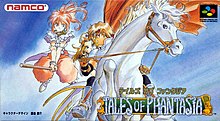
The Tales series is a franchise of fantasy role-playing video games published by Bandai Namco Entertainment, and developed by its subsidiary, Namco Tales Studio until 2011 and presently by Bandai Namco Studios. First begun in 1995 with the development and release of Tales of Phantasia for the Super Famicom, the series currently spans seventeen main titles, multiple spin-off games and supplementary media in the form of manga series, anime series, and audio dramas.

Tales of Symphonia is an action role-playing video game developed by Namco Tales Studio and published by Namco for the GameCube. The fifth main installment of the Tales series, it was released in Japan on August 29, 2003, in North America on July 13, 2004 and in Europe on November 19, 2004. In Japan, the game was ported for the PlayStation 2 with additional content and was released on September 22, 2004.
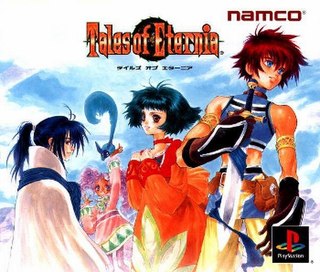
Tales of Eternia, known as Tales of Destiny II in its original North America release, is an action role-playing game published by Namco as the third main title in their Tales series. Initially released for the PlayStation in November 2000 in Japan, an English version was later released in North America in September 2001. It was developed by members of Telnet Japan's "Wolfteam", who had previously worked on its predecessors Tales of Phantasia and Tales of Destiny. The game's producers gave it the characteristic genre name RPG of Eternity and Bonds. A port was released for the PlayStation Portable handheld in Japan in March 2005, and the PAL region in February 2006.
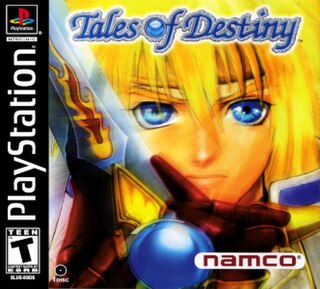
Tales of Destiny is an action role-playing game originally developed by Telenet Japan's "Wolf Team" as the second main title in Namco's "Tales of" series. Originally released for the PlayStation in Japan in December 1997, an English version was later made available in North America in September 1998. The game features many of the same development staff as its predecessor, Tales of Phantasia, including composers Motoi Sakuraba and Shinji Tamura, with character designs by series newcomer Mutsumi Inomata. Its producers gave it the characteristic genre name RPG of Destiny. A remake for the PlayStation 2 was released in November 2006, which was followed by an updated version called Tales of Destiny Director's Cut in January 2008, both exclusive to Japan. The remake was also given its own unique genre name by its producers as RPG called 'Destiny'.

Tales of Legendia is an action role-playing game that was developed and published by Namco for the PlayStation 2 as the seventh main title in their Tales series. Originally released in Japan in August 2005, it was later made available in English in North America in February 2006. The game was created by a development team known collectively as "Project MelFes", which was composed of members of Namco's Tales Studio along with developers from the company's Tekken and Soulcalibur fighting game series. It features character designs from anime artist Kazuto Nakazawa and music from composer Go Shiina, as well as songs performed by Do As Infinity, Donna Burke, and Kanon. Its producers gave it the characteristic genre name RPG Where Bonds Spin Legends.
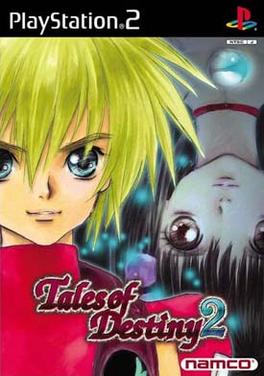
Tales of Destiny 2 is a Japanese action role-playing game, co-developed by Wolfteam and Telenet Japan, and published by Namco. It is the fourth main entry in the Tales series of video games, and a direct sequel to 1997's Tales of Destiny. It released on PlayStation 2 (PS2) in November 2002 in Japan, March 2003 in South Korea and August 2003 in China. The overseas versions were published by Sony Computer Entertainment. An updated port for the PlayStation Portable (PSP), developed by Alfa System, was released in February 2007, and March of the same year in South Korea. This version was published by Namco Bandai Games. Neither version has received a western release.

Tales of Rebirth is a Japanese action role-playing game published for the PlayStation 2. It is the sixth main entry of Namco's Tales series of video games. The game was developed by Namco Tales Studio and published by Namco Games. The game was released for the PlayStation 2 on December 16, 2004, and then later re-released on the PlayStation Portable on March 19, 2008. Rebirth, set in a world populated by humans (Huma) and beast people (Gajuma), follows the adventures of Veigue Lungberg, a human whose friend Claire Bennett is kidnapped by agents of Agarte, heir to the throne of the kingdom of Karegia. Setting out to rescue Claire, Veigue and those who join him becomes entangled in escalating racial conflicts consuming the land.
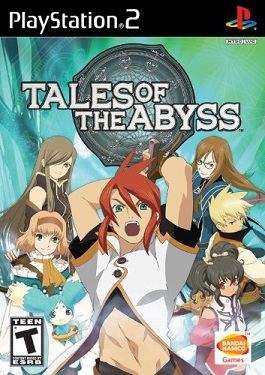
Tales of the Abyss is an action role-playing game developed by Namco Tales Studio as the eighth main title in their Tales series in celebration of the series' 10th anniversary. Originally released for the PlayStation 2, the game was published by Namco in Japan in December 2005, and Bandai Namco Games in North America in October 2006. Its development team included director Yoshito Higuchi, producer Makoto Yoshizumi, and character artist Kōsuke Fujishima. The game features music by series composers Motoi Sakuraba and Shinji Tamura, and includes the opening theme song "Karma" by Bump of Chicken, which is replaced with the instrumental version in the western release. Namco has given Tales of the Abyss the characteristic genre name To Know the Meaning of One's Birth RPG. A port for the Nintendo 3DS handheld was released in Japan in June 2011, followed by an Australian and European release in November 2011 and a North American release in February 2012.
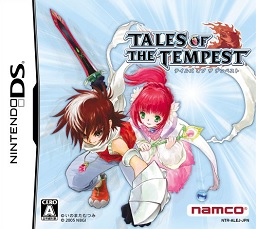
Tales of the Tempest is an action role-playing game developed by Dimps and Namco Tales Studio, and published by Bandai Namco Games for the Nintendo DS exclusive in Japan. An entry in the Tales series, it was released on October 26, 2006. The game makes use of the Tales series' recurring Linear Motion Battle System, customized so characters and actions can be controlled and determined using the DS touch screen, as well as incorporating multiplayer elements. The opening of the game was made by Production I.G and uses the music VS composed by Koda Misono.
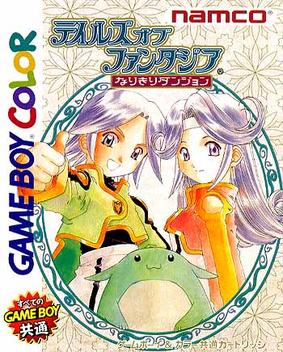
Tales of Phantasia: Narikiri Dungeon is a role-playing video game for the Game Boy Color released by Namco on November 10, 2000, selling 136,000 copies. Tales of Phantasia: Narikiri Dungeon's characteristic genre name is Dungeon RPG. It is the first sequel in the Tales series, which normally does not have connected storylines. The story begins 205 years after the beginning of Tales of Phantasia.

Tales of Innocence is an action role-playing game, developed and released for the Nintendo DS and PlayStation Vita. Innocence is the ninth main installment in the Tales series, developed by Alfa System and published by Bandai Namco Games. It was released in December 2007. A remake for the Vita developed by 7th Chord, Tales of Innocence R, was released in January 2012. Multiple elements are carried over from previous entries in the series, including the action-based Linear Motion Battle System. Innocence R includes both an updated battle system and additional story content. Both versions remain exclusive to Asia.
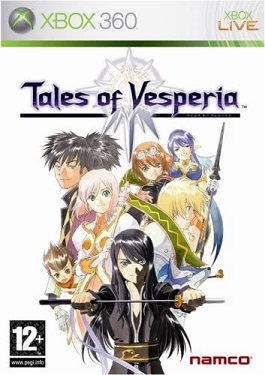
Tales of Vesperia is an action role-playing game developed by Namco Tales Studio. The tenth mainline entry in the Tales series, it was released for the Xbox 360 and published in Japan and North America by Namco Bandai Games in 2008, and in European territories by Atari in 2009. An expanded port of the game for the PlayStation 3 was released in 2009 in Japan. An enhanced version, subtitled Definitive Edition, was released for the Nintendo Switch, PlayStation 4, Windows, and Xbox One in January 2019. The gameplay is similar to previous Tales games, featuring a new version of the series' trademark action-based "Linear Motion Battle System", while also introducing new elements such as online leaderboards.

Tales of Hearts is an action role-playing game released for the Nintendo DS in Japan and the PlayStation Vita worldwide. It is the eleventh main entry in the Tales series, developed by Namco Tales Studio and published by Bandai Namco Games. The Japan-exclusive DS version received two editions: the "Anime Edition," featuring cutscenes by Production I.G, and the "CG Movie Edition," featuring CGI cutscenes created by Shirogumi. A remake of the game, Tales of Hearts R, was released on the Vita in March 2013 and later released in western regions in November 2014. Hearts R was also ported to iOS and released in Japan in October 2013 although it was pulled from the App Store on March 31, 2016, and therefore no longer available for download. Hearts R was developed by 7th Chord and includes staff from Bandai Namco Studios.
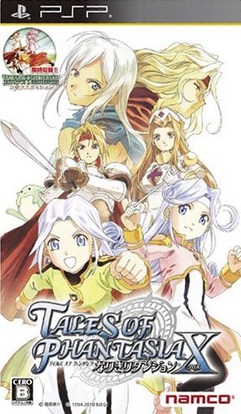
Tales of Phantasia: Narikiri Dungeon X is a remake of the Game Boy Color role-playing video game, Tales of Phantasia: Narikiri Dungeon, for the PlayStation Portable developed by Namco Tales Studio and published by Namco Bandai. It released in Japan on August 5, 2010. The original game was the first sequel in the Tales series, which normally does not have connected storylines. The story begins 205 years after the beginning of Tales of Phantasia. The game's theme song is Glass Flower and was sung by Hanako Oku.
Tales of the World: Dice Adventure was a web browser-based board game in the Tales series of video games. It was released on April 26, 2012 in Japanese language only, though it was playable in any region with a Namco Bandai ID. Service for the title official ended on June 28, 2013.

Tales of Xillia is an action role-playing game released exclusively for the PlayStation 3. It is the thirteenth main installment of the Tales series and is developed by Namco Tales Studio with Namco Bandai Games as the publisher. The game was released in Japan on September 7, 2011, and was localized in North America and PAL region in August 2013. The game takes place in a fictional world called Rieze Maxia where humans and ethereal spirits live in harmony. It follows Jude Mathis and Milla Maxwell who elude government officials after sabotaging a weapon of mass destruction known as the Lance of Kresnik. The plot's central theme is Yuruginaki shinnen no RPG.

Tales of Xillia 2 is an action role-playing game for the PlayStation 3 released on November 1, 2012, in Japan. It is the fourteenth core product in the Tales series and was developed and published by Bandai Namco Games. The game was localized for North America and Europe in August 2014.

Tales of Zestiria is an action role-playing game. It is the fifteenth main entry in the Tales series, developed by Bandai Namco Studios and published by Bandai Namco Entertainment. It was released in January 2015 in Japan on the PlayStation 3. For Western release in October of the same year, it was also ported to PlayStation 4 and Windows via Steam. The PS4 version was released in Japan in July 2016. As with previous entries in the Tales series, the game uses a variation of the action-based Linear Motion Battle System, with additional elements including a navigable open world, and the ability for certain characters to fuse into a single entity in battle to deliver powerful attacks.
